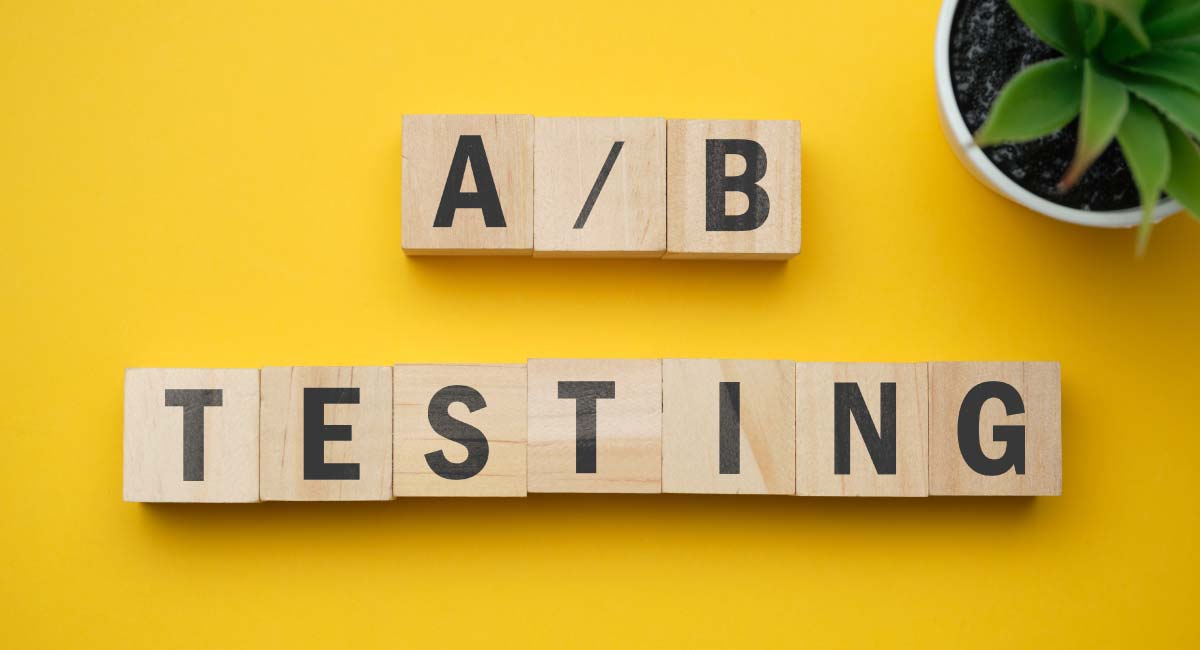Statistics help digital marketers understand how successful their ad campaigns, marketing events, and websites are. Testing yields those necessary statistics, and many different forms of testing are available. Today, we’re answering the question, “What is A/B testing?”
This article focuses on A/B testing in data science, including defining the term, explaining its importance, showing how it works and how to conduct it, when to use it, and other valuable tidbits. We’ll round things out by discussing the common mistakes associated with A/B testing, real-world applications, what tools data scientists use to conduct A/B testing, and a data science bootcamp professionals can take to boost their careers.
Let’s get the ball rolling with a definition. What is A/B testing in data science?
What is A/B Testing in Data Science?
A/B testing, also known as “split testing,” is a method employed extensively in data science. It allows data scientists to generate accurate, evidence-based decisions using the insights gained from testing two different variables. A/B testing is an experiment on two variants using a given metric to see which performs better.
A/B testing divides traffic into two groups and serves one group, the A/B version, and the other, the control. It helps data scientists determine what works and doesn’t work for the organization and enables them to evaluate the impact of different versions on conversion and response rates.
Also Read: What is Exploratory Data Analysis? Types, Tools, Importance, etc.
Why A/B Testing is Important
A/B testing in data science is critical to data-driven decision-making because it helps data scientists eliminate guesswork by comparing two versions of a marketing campaign, web page, or product feature to see which performs better.
Additionally, A/B testing in data science helps marketers better understand user behavior, which is vital in user experience (UX) design, conversion rate optimization, and similar fields.
A data scientist or marketing professional who runs an A/B test can isolate the variables directly affecting the outcome. This process lets data scientists identify whether the changes made had a positive, negative, or null impact on user behavior. The insights gleaned from A/B testing can then be used to make better, more informed decisions and optimize the various aspects of a service or product.
A/B testing is a valuable part of data science and marketing efforts because our world increasingly relies on the ever-growing volumes of data generated daily. Numbers must back up business decisions, and A/B testing helps fill that gap.
When to Use A/B Testing
Since every form of testing has strong points and places where it does the most good, when should we use A/B testing? A/B testing excels in situations like testing incremental changes. Incremental changes include UX adjustments, new features, page load times, and ranking. Here, researchers can compare outcomes before and after the modifications to ascertain whether the changes have the desired effect.
On the other hand, A/B testing only functions effectively when used to test significant changes, such as new branding, new products, or a whole new user experience.
Now, let’s look at how to perform an A/B test.
How to Conduct an A/B Test
There are three stages in conducting A/B tests.
Generate Your Hypothesis
Before running your tests, you must generate your hypothesis. A hypothesis is an unproven assumption about how the natural world functions. Alternatively, it’s a reasonable prediction about something in the immediate environment that can be verifiable via observation or experimentation. You must generate a null hypothesis and an alternative hypothesis.
- Null hypothesis. A null hypothesis declares that sample observations result completely from chance. In the context of an A/B test, the null hypothesis states that there is no difference between the control and variant groups.
- Alternative hypothesis. The alternative hypothesis states that a non-random cause influences sample observations. In the context of an A/B test, the alternative hypothesis says there’s a difference between the control and variant groups.
Regardless of the hypothesis, you should follow the PICOT rules when formulating it.
- Population. This is the group of people participating in the experiment.
- Intervention. This is the new variant in the study.
- Comparison. This refers to what reference group you are using to compare against your intervention.
- Outcome. The outcome signifies what result you plan on measuring.
- Time. Time refers to the duration of the experience, including when and for how long the data will be collected.
Create the Control and Test Groups
Once you have developed your hypotheses, you need to create your control and test (variant) groups. In this step, remember these two vital concepts: random sampling and sample size.
- Random Sampling. In random sampling, each sample in the population has an equal chance of getting selected. Random sampling is crucial in hypothesis testing because it removes sampling bias; it’s essential to eliminate bias because the A/B test results must represent the whole population rather than the sample itself.
- Sample Size. Before conducting the test, determining the minimum sample size for the A/B test is essential. This way, you eliminate under-coverage bias or bias from sampling too few observations.
Run the A/B Tests and Gather the Results, Either Rejecting or Keeping the Null Hypothesis
After you conduct the experiment and collect the data, determine if the difference between the control and variant groups is statistically significant. How do you do this? By following these three simple steps:
- Set your alpha, which is the probability of making a type 1 error. In most cases, the alpha is set at 5% or 0.05.
- Determine the probability value (p-value). Start by calculating the t-statistic using the formula below, provided by isixsigma.com.
- Finally, compare the p-value to the alpha. Don’t reject the null if the p-value is greater than the alpha.
Alternately, some sources posit that there are five stages associated with A/B tests:
- Run the experiment
- Measure the results
- Determine the conversion to improve
- Hypothesize changes
- Identify the variables and create variations
Also Read: What is Data Wrangling? Importance, Tools, and More
The Common Mistakes to Avoid in A/B Testing
There are a few significant mistakes that data science experts risk committing. They are:
- Invalid Hypothesis. The entire experiment is predicated solely on the hypothesis. What needs to be changed, what justifies these changes, and what are the desired results? The chance of the test succeeding diminishes if you start with an incorrect hypothesis.
- Testing too many components simultaneously. Try to run as few tests as possible at once. Running too many tests simultaneously might be challenging to discern which aspect contributed to success or failure. Therefore, it’s vital to prioritize tests for effective A/B testing.
- Ignoring Statistical Significance. Your opinion of the test doesn’t matter. Let the test run its full course, whether it succeeds or fails, so that it acquires statistical significance.
- Not taking external factors into account. Tests should be run during comparable times so that you may obtain significant findings. For example, comparing website hits on high-traffic days to days with the lowest traffic because of external factors such as sales or holidays is unfair and will yield a flawed conclusion.
Real-World Applications of A/B Testing
So, how does A/B testing work in the real world? Check out this pair of examples and see how A/B testing in data science contributes to the digital economy.
User Experience Design
A/B testing is used in user experience (UX) design to identify obstacles that prevent customers from optimally interacting with a website, service, or product. It helps UX designers determine what adjustments are required on the website or application to give consumers a seamless and delightful user experience.
For example, UX designers could run an A/B test for two different shopping cart/checkout process versions on an e-commerce site and see which one results in a more complete, effortless purchase. So, A/B testing lets designers make better data-driven design decisions.
Marketing Analytics
A/B testing is widely used in marketing analytics to optimize marketing efforts. It lets marketers test different versions of their campaigns and messages and discern which resonates the most with their prospective customers.
Only after conducting extensive A/B testing can marketers accurately decide which changes are worth the effort.
From landing page designs to e-mail marketing campaigns, A/B testing plays a significant part in today’s digital marketing strategies. A/B testing minimizes risk and increases the chances of a successful marketing campaign.
Tools Used for A/B Testing in Data Science
A/B testing in data science has many tools to make the job easier. Here’s a list of 13 popular A/B testing tools. Choosing the ideal A/B testing tool largely depends on your unique needs. When you’re ready to shop for A/B testing tools, consider crucial factors such as pricing, ease of use, and analysis level.
Ensure the tool you choose supports your marketing goals, including conversion rate optimization, boosting user engagement, or even reducing churn rate. Picking the right testing tool will play a significant role in conducting a successful A/B test and leveraging data for organizational success.
Also Read: What is Spatial Data Science? Definition, Applications, Careers & More
Do You Want Data Science Training?
Data science is gaining greater prominence in digital marketing thanks to the profusion of data available online. Consequently, data science is a great career option, offering generous compensation, job security, and growth opportunities. If you’re interested in gaining job-ready skills in data science, either to round out your skill set or as part of a career change, consider this online Post Graduate Program in Data Science.
This 44-week online bootcamp imparts data science and generative AI skills through a high-engagement learning experience. You will learn about descriptive statistics, ensemble learning, conversational AI, data visualization, and more. In addition, you will gain exposure to generative AI tools like ChatGPT, DALL-E, Midjourney, etc.
Indeed.com reports that data scientists can earn an annual average salary of $124,393. Sign up today and gain that valuable set of skills and training that could take you far in a new career in data science.
You might also like to read:
Data Science and Marketing: Transforming Strategies and Enhancing Engagement
An Introduction to Natural Language Processing in Data Science
Why Use Python for Data Science?






